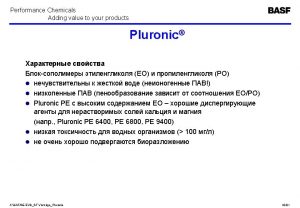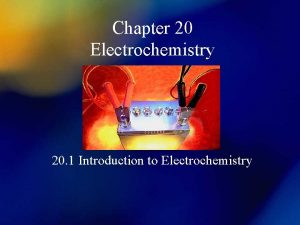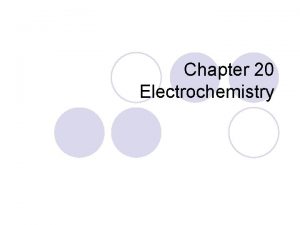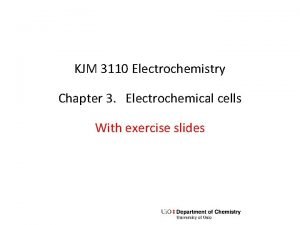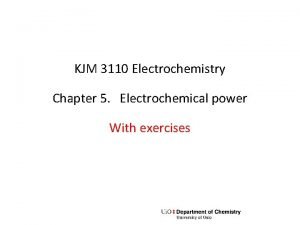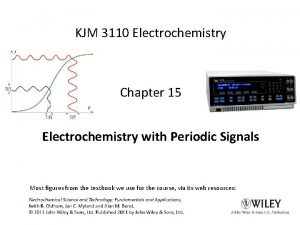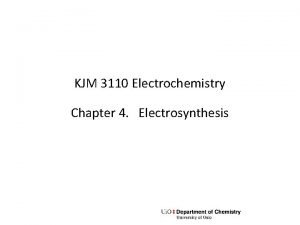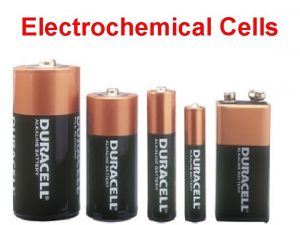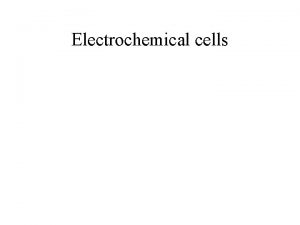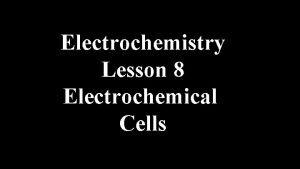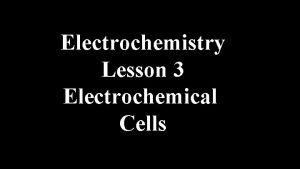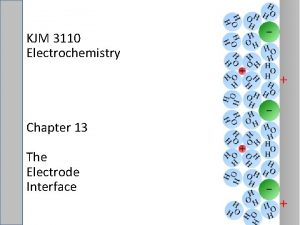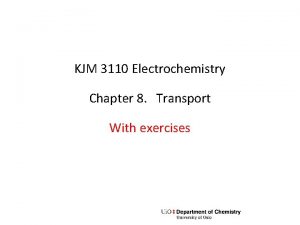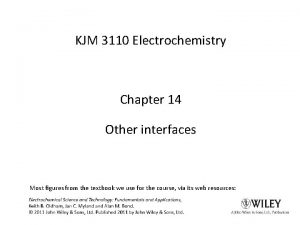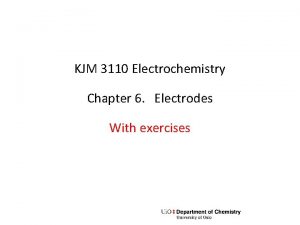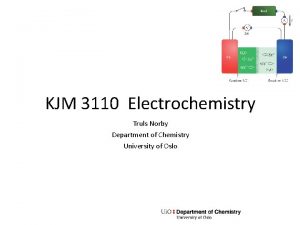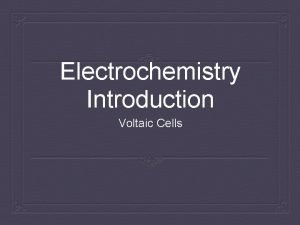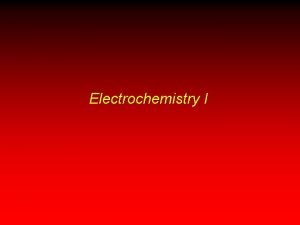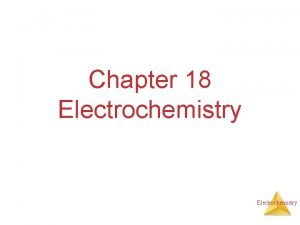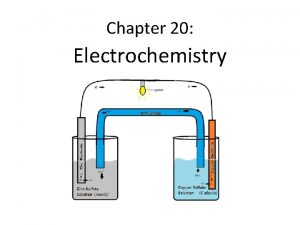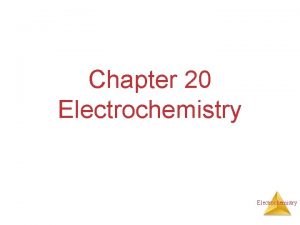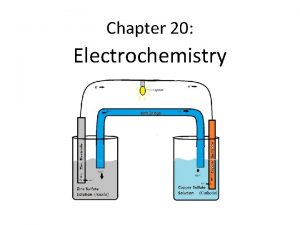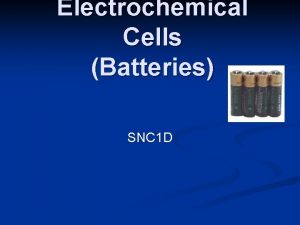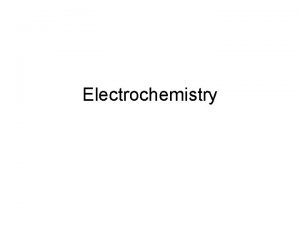KJM 3110 Electrochemistry Chapter 3 Electrochemical cells Recap


























- Slides: 26

KJM 3110 Electrochemistry Chapter 3. Electrochemical cells

Recap from Ch. 1 Electricity • In Chapter 1 we familiarised ourselves with the most fundamental concepts of electricity itself. • Charge Different disciplines, textbooks, articles, teachers use different symbols for many of these entities. For instance, e vs q, q vs Q, f vs F, U vs E, i vs I… • Electrostatic force • Electrical work We could try to be completely consistent here. • Potential and voltage • Capacitance Instead we allow variations, to train ourselves for reality, but aim to always define and/or • Current make clear what we mean. • Conductance and resistance • DC and AC voltage and current and impedance

Remaining parts of Ch. 1 we considered non-mandatory for now • Electrical circuits • Models of electrochemical behaviour • AC signals • AC impedance, Fourier transforms • Real and imaginary contributions, loss, and power dissipated

Ch. 1 Summary – four selected important concepts • Charge and field • Charge capacitance of insulator (dielectric) • Current transport in a conductor • Conductivity

A brief look at Chapter 2 Chemistry; Concepts

A brief look at Chapter 2 Chemistry; Summary

Electrochemical cells Lead-acid cell as example

The lead-acid cell – half and full cell reactions Positrode Negatrode Total, chemical, cell reaction Total, electrical

The lead-acid cell – Gibbs energy change The activity of pure condensed phases is defined as unity. Hence, for instance a. Pb(s) = 1

The lead-acid cell – electrical work and cell voltage Electrical work w = ΔG (J) = -neΔE W = NAw = ΔG (J/mol) = -n. FΔE

The lead-acid cell – cell voltage

The lead-acid cell – standard state Standard state: All activities = 1 Temperature can, but need not be, 298. 15 K This is not equilibrium, it is the standard state

The lead-acid cell – equilibrium From Ch. 2: Now becomes: Important to understand this

Basic electrochemical thermodynamics since and Nernst equation

The lead-acid cell – galvanic operation Galvanic cell: The chemical potential differences – the spontaneous change according to ΔG – drives the cell. Battery under discharge Fuel cell Cathode (positrode) Anode (negatrode) + -

The lead-acid cell – electrolytic operation Electrolytic cell: The applied electrical potential difference drives the cell against the spontaneous change according to ΔG. Battery under charge Electrolyser Anode (positrode) Cathode (negatrode) + -

The lead-acid cell – total operation Electrolytic cell + Galvanic cell - + Anode (positrode) Pb 4+ + 2 e- ↔ Pb 2+ Cathode (negatrode) Pb 2+ + 2 e- ↔ Pb -

Electrochemical cells – three modes of operation Polarisation curve for a lead-acid cell aka Open Circuit Voltage (OCV)

Electrochemical cell and an «impractical» cell…. ?

Cells with junctions – The Daniell cell Total reaction Self study and check – this and Eqs. 3. 20 -3. 23 is standard from general and physical chemistry. What goes on at the diaphragm under open circuit and under galvanic conditions?

Electrolyte junctions - liquid junctions Junction potentials arise from different mobilities µ and charges z for anions and cations. KCl(aq) gives almost zero junction potential

Cells with junctions – The Daniell cell with a KCl salt bridge Avoid parasitic reactions

Electrochemical series Half reaction and reduction potentials Galvanic cell

Another solution – bipolar electrodes We consider taking the details here as part of our colloquium….

Semipermeable and solid electrolyte membranes • Semipermeable membranes • Selective permeation • Allows recharging without e. g. cation intermixing • Adds resistance • Solid electrolyte membranes • E. g. Y-stabilized Zr. O 2 (YSZ) • Selective transport • Proton conducting solids. Other ions?

Summary Ch. 3 Electrochemical cells • Equilibrium • I=0 • Galvanic operation • I>0 • Electrolytic operation • I<0
 Nondisjunction in meiosis
Nondisjunction in meiosis Pluronic pe 10100
Pluronic pe 10100 Occaml
Occaml Ctech collects
Ctech collects What is the 8-bit unsigned binary result of 5610 − 3110?
What is the 8-bit unsigned binary result of 5610 − 3110? Boletin 3110
Boletin 3110 Ap chemistry chapter 18 electrochemistry test
Ap chemistry chapter 18 electrochemistry test Chapter 20 review electrochemistry
Chapter 20 review electrochemistry Ap chem electrochemistry review
Ap chem electrochemistry review Chapter 21 electrochemistry
Chapter 21 electrochemistry Electrolysis vs voltaic cell
Electrolysis vs voltaic cell Chapter 20 electrochemistry
Chapter 20 electrochemistry Paranasal sinuses development
Paranasal sinuses development Reabsorption
Reabsorption Parafollicular
Parafollicular How are mitosis and meiosis similar
How are mitosis and meiosis similar Somatic cells vs germ cells
Somatic cells vs germ cells Red blood cells and white blood cells difference
Red blood cells and white blood cells difference Prokaryotic versus eukaryotic
Prokaryotic versus eukaryotic Animal rights and animal welfare venn diagram
Animal rights and animal welfare venn diagram Prokaryotic cells vs eukaryotic cells
Prokaryotic cells vs eukaryotic cells Why did robert hooke name cells “cells”?
Why did robert hooke name cells “cells”? Masses of cells form and steal nutrients from healthy cells
Masses of cells form and steal nutrients from healthy cells Pseudostratified vs simple columnar
Pseudostratified vs simple columnar What cell type
What cell type Is a staphylococcus cell prokaryotic or eukaryotic
Is a staphylococcus cell prokaryotic or eukaryotic Cells and life lesson 1 answer key
Cells and life lesson 1 answer key

